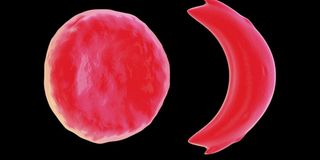Getting it right on sickle cell treatment

Dosing effectiveness for drugs used by children with sickle cell now under scrutiny. PHOTO | FOTOSEARCH
Children with sickle cell anaemia may soon start to receive more effective dosage treatment.
This is after medical scientists conducting dosage clinical trials at Makerere University in Uganda discovered more efficiency in the revised dose administration of the hydroxyurea drug.
Although this drug has previously been in use against sickle cell anaemia, it is only now that its dosing effectiveness in children has been put under clinical trials.
According to Dr Robert Opoka, who led the team of researchers at Makerere University and Mulago Referral Hospital, the current form of low, fixed dosage is not effective when compared to a dose escalation in children. “A lower fixed dose of 20mg per kilogramme of body weight per day does little to combat the sickle disorders in comparison to a dose of 25mg per kilogramme of body weight, and an escalation to 35mg per kilogramme of body weight where the child is able to tolerate the drug,” said Dr Opoka.
LIFE-THREATENING
Sickle cell anaemia is considered a life-threatening haemoglobin disorder. The condition distorts red blood cells and causes them to misshapen into sickle shape.
This results in the cells dying early, which creates a shortage of healthy red blood cells. Globally, over 300,000 children are born with sickle cell anaemia every year. Over 80 per cent of these children are born in Sub-Saharan Africa.
In Kenya, it is estimated that three out of 10 people who live in the coastal and western regions are likely to have this disorder. According to Dr Chandy John, a physician scientist from Indiana University School of Medicine, who co- authored the study, the Sub-Saharan Africa region will be prioritised both in dosing and provision of the drug.
AFFORDABLE DRUGS
“The Sub-Saharan region is worst hit both by the disease and the lack of optimal dosing and monitoring. These findings are now expected to be a pathway for the expansion of hydroxyurea treatment and the provision of affordable drugs,” said Dr John in the study published in the New England Journal of Medicine.
The hydroxyurea drug works in patients with sickle cell anaemia by increasing foetal haemoglobin and decreasing the number of attacks. At the same time, the World Health Organization estimates that approximately 5 per cent of the world’s population carries trait genes for haemoglobin disorders, mainly, sickle-cell disease and thalassaemia.
Apart from treating sickle cell anaemia, the hydroxyurea drug is also used in the treatment and management of cervical cancer, myelogenous leukaemia (popularly known as myeloid leukaemia or cancer of the white blood cells) and essential thrombocythemia (a condition in which the body produces too much blood platelets).



